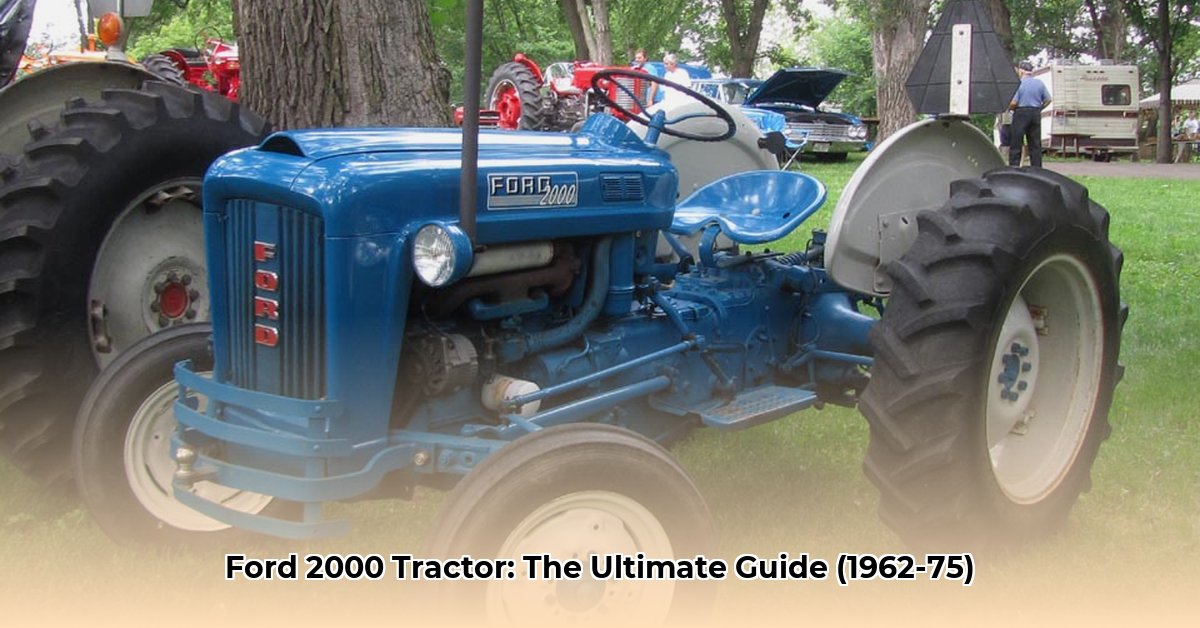
Thinking about adding a classic Ford 2000 tractor to your collection or farm? Manufactured from 1962 to 1975, these robust machines offer a blend of vintage charm and dependable power. However, significant variations exist across model years, making informed decision-making crucial. This comprehensive buyer's guide navigates the complexities, providing you with the knowledge to choose the perfect Ford 2000 for your needs. For wiring diagrams, check out this helpful resource: wiring diagram.
Under the Hood: Engine Power and Performance
The Ford 2000's engine is the heart of its operation. Early models (approximately 1962-1968) predominantly featured a powerful four-cylinder engine, delivering around 48.4 gross horsepower (a significant amount of power for its time). Later models (approximately 1969-1975), however, transitioned to a three-cylinder design, resulting in a lower power output of approximately 36.4 PS (roughly 27 horsepower). Both engine types were available in gasoline and diesel variants. The four-cylinder engine provided superior power for heavy-duty applications like plowing, while the three-cylinder might have offered improved fuel efficiency – an important factor to consider depending on your priorities. Did you know that the type of fuel (gasoline vs. diesel) also significantly impacts fuel consumption and maintenance requirements?
Shifting Gears: Transmission Options
Transmission choices significantly influenced the Ford 2000's versatility. Early models often boasted a simple four-speed transmission. Subsequent models expanded options to include six, eight, and even twelve-speed transmissions. This evolution drastically altered operational efficiency. A four-speed transmission offered limited speed control, while a twelve-speed offered much finer control to match the tractor's speed to the task at hand, optimizing performance and reducing wear. Precise gear ratios for each specific transmission option often require consulting original manuals or dedicated online forums.
Hydraulic System Analysis: Lifting Power and Capabilities
The Ford 2000's hydraulic system, while largely consistent, exhibited subtle variations across models. All models utilized an open-center system (a system where hydraulic fluid is constantly circulating), but pump flow rates and lift capacities differed. While some sources suggest a flow rate around 4 gallons per minute and a lift capacity near 2360 pounds, these figures are not universally consistent across all models and years. Verifying these specifications for your specific tractor is crucial. The hydraulic system's capabilities directly determine the types and sizes of attachments that can be used, ranging from plows and cultivators to loaders and backhoes. Understanding these limitations is key before purchasing.
Model Year Variations: A Detailed Look at the Evolution
The Ford 2000’s production spanned thirteen years, resulting in numerous variations. Pinpointing the exact specifications for each model year requires diligent research. Serial numbers, often located on a metal plate on the tractor frame, are essential for identification. However, even with serial numbers, precise specification details can be challenging to find, highlighting the importance of consulting various sources to ensure accuracy. Multiple online resources and Ford tractor specialist communities are invaluable in this process.
Parts Availability and Restoration: A Practical Perspective
Owning a classic vehicle comes with its challenges. Sourcing parts for the Ford 2000 varies depending on the part and the model year. While some common parts are readily accessible through online vendors and specialized suppliers, others may require more extensive searching, resorting to salvage yards or collaborations with other Ford 2000 owners. Restoration projects require significant time, mechanical skill, and resourcefulness. Before undertaking a restoration, thoroughly investigate the potential difficulties in locating specific components; some parts can be extraordinarily challenging to find.
Key Specifications at a Glance
The following table provides a general comparison between early and later models. Remember, precise specifications vary widely, and these figures serve as estimates.
| Feature | Early Models (approx. 1962-1968) | Later Models (approx. 1969-1975) |
|---|---|---|
| Engine Type | Primarily Four-Cylinder | Primarily Three-Cylinder |
| Engine Power | ~48.4 hp (gross) | ~27 hp |
| Transmission | Typically 4-speed | 4, 6, 8, or 12-speed options |
| Hydraulics | Open-center (specs vary) | Open-center (specs vary) |
Remember to always cross-reference information with your tractor’s serial number for the precise specifications. This guide serves as a helpful starting point for your research.